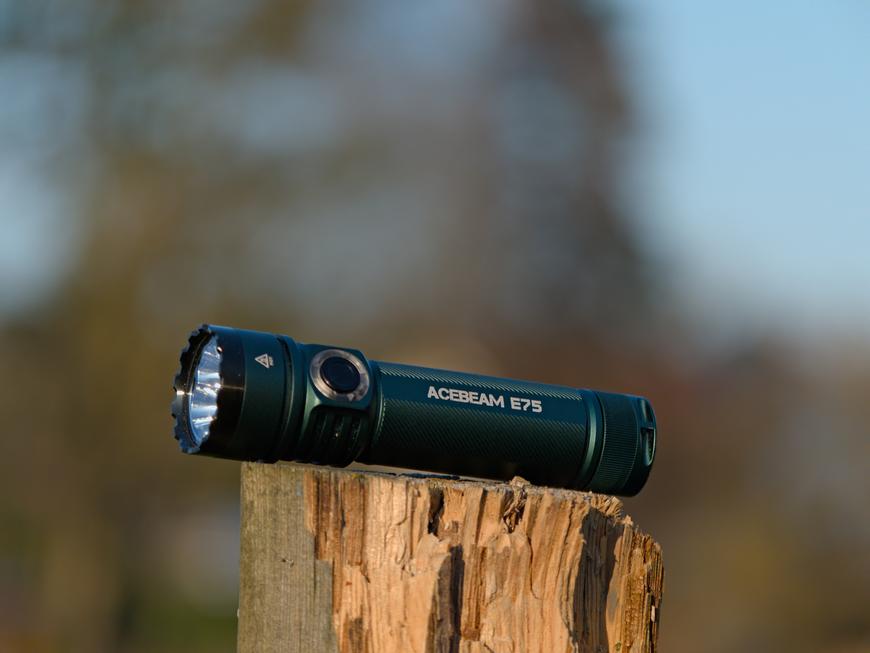Some tools do their jobs so well they’re a little boring to write about. The E75 provides everything most of us could want in a midsize flashlight, and very little we wouldn’t. It gets so much right, I had to resort to things like button feel to ensure the list of downsides isn’t empty.

Read more about one of my favorite lights of all time at zakreviews.com
2 Thanks
Excellent review!
The spectral readings seem dubious to me. From the beam comparison to the BLF348 (assuming 219B 4500K version which is around 4600-4700K) it’s clear that the E75 is warmer, which is not consistent with a 5500K+ CCT as measured.
And I agree with your suspicion that the output readings might be on the higher side–the turbo output number is 57% higher than what ZeroAir gave.
1 Thank
I’ve noticed 219Bs usually look cooler than they test, and cameras often exaggerate the effect. The M200 is a better comparison; it’s also a 519A and it tests around 4400K. The E75 looks much cooler than the M200, and the spectrophotometer agrees.
Zeroair measures lumens with a tube, and from looking at results others have shared, I’m inclined to say tubes tend to underrate floody lights and overrate throwy ones. I won’t claim my measurements are any more accurate, but they’re subject to different errors.
1 Thank
Makes sense about the 219B. Iirc the M200 has a 4500K 519A (which typically tests around 4200-4300K from what I’ve seen, possibly lower if the reading is taken in the hotspot of a reflector light), and from your comparison the difference is pretty much what I see irl between a 4500K and 5000K 519A.
I’d say that the CCT readings are too high even if the emitters are 5700K–the 6233K on turbo seems extremely unlikely (as the emitters are not driven into the angry-blue range), and the hotspot (where the measurement is taken) is the warmest part of the entire beam. Maybe it would be good to check the beam against noon sunlight–if the E75 appears warmer at any point, then the readings are definitely off.
I see about the different errors from different methods of output measurement. Maybe a theoretical upper bound for output can be computed from emitter test graphs. Assuming 100% system efficiency both electrically and optically, we have 6060/4=1515mA per emitter, which would be (according to either datasheet or blf test) no more than 500lmx4=2000lm, so I’m inclined to guess that both zeroair’s numbers and yours are optimistic. Though it is also possible that the current draw is higher in reality than either of you measured.
1 Thank
I’m fairly confident in the CCT readings. It looked cooler than any of my 5000K lights. I took several readings, which were consistent, and it’s definitely visibly higher in the highest mode. I wouldn’t be completely shocked if most E75s are 5000K, but a few were 5700K by mistake (i.e. they got a reel of LEDs in the wrong bin).
6060/4=1515mA per emitter
That’s not how boost drivers work. Instead, we have:
6.06A * 4.0V (estimated voltage sag under initial load) = 24.24W
24.24W / 4 = 6.06W per emitter
Now we can find current and voltage values that get us close to 6W from this test by djozz, which gets us 651lm per emitter, or 2604 total.
But we’re not done yet. I took that reading with an ammeter in series. Those add a lot of resistance at higher current and tend to read lower as a result. I’m not entirely sure it’s responsible of me to publish numbers over 2A or so without a clamp meter.
There’s a way to cross-check this: measure current and output at the same time. I dedomed the LEDs at the end of the review, so the numbers are going to be lower (though still very possibly optimistic). I see 3617 lumens with the tailcap on, and 2550 through the ammeter reading right at 6A.
So there we have it: 6A does not represent actual operating conditions. I’ve removed that reading from the table. According to djozz, we would need about 11A for 4000 lumens, though it wouldn’t surprise me if these are a higher flux bin, so maybe 10.
I should probably get a clamp meter… and maybe a calibrated integrating sphere.
2 Thanks
Thank you for the further info! It’s entirely conceivable that they got the wrong CCT for a small fraction of the lights, it’s extremely hard to distinguish close CCTs visually by just looking at the phosphor color. I think some early batches of S21F (tint ramping) might have had the 5000K instead of 5700K, erring in the opposite direction. I will say that wherever they sourced the emitters from, the 4 of them appear remarkably consistent in CCT, tint, and output from that moonlight shot, better than Simon’s 5-step and even Hank’s 3-step binning.
Thanks for the correction on the driver math, it makes more sense for power to be equidistributed across emitters instead of amperage. I was being lazy/sloppy and assumed that they are interchangeable as first-order approximations to each other, which as you have shown is not the case–the difference is quite significant.
It is extremely difficult to get accurate current readings without a dedicated high current setup; my Convoy 5A drivers never measure above 3.5-ish A. 10-11A for 4000 lumens sounds reasonable, without factoring in optical losses. Thank you for updating the data in the review!
